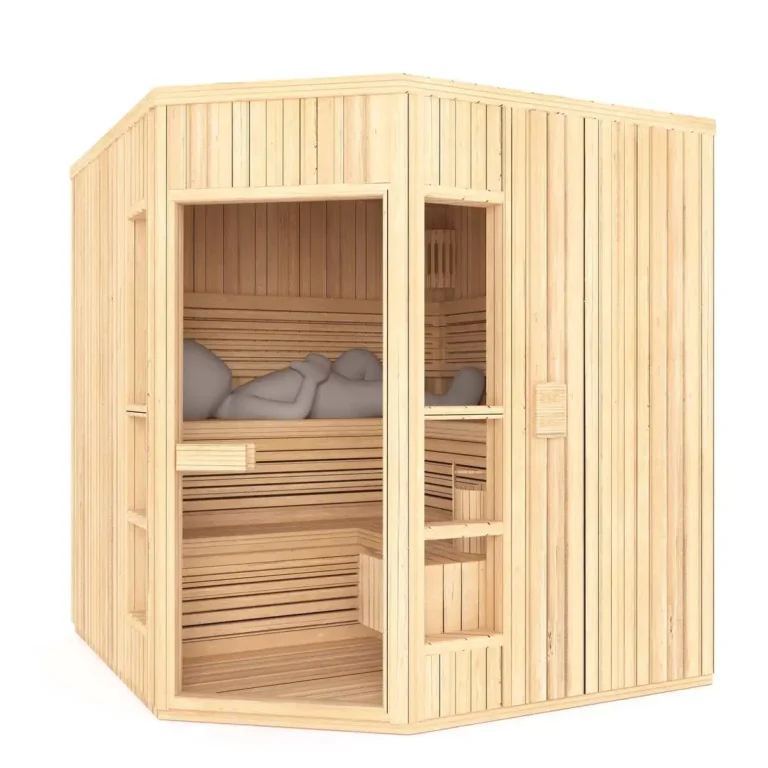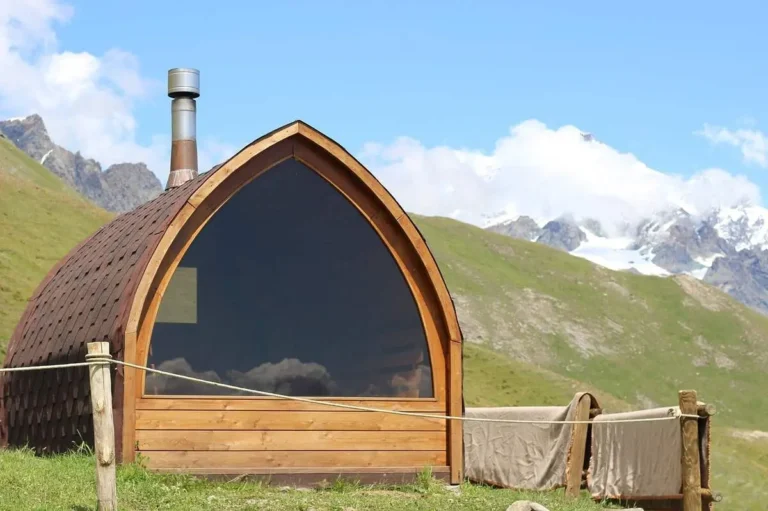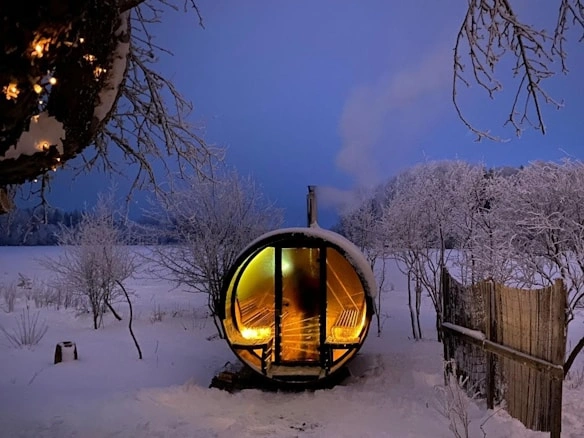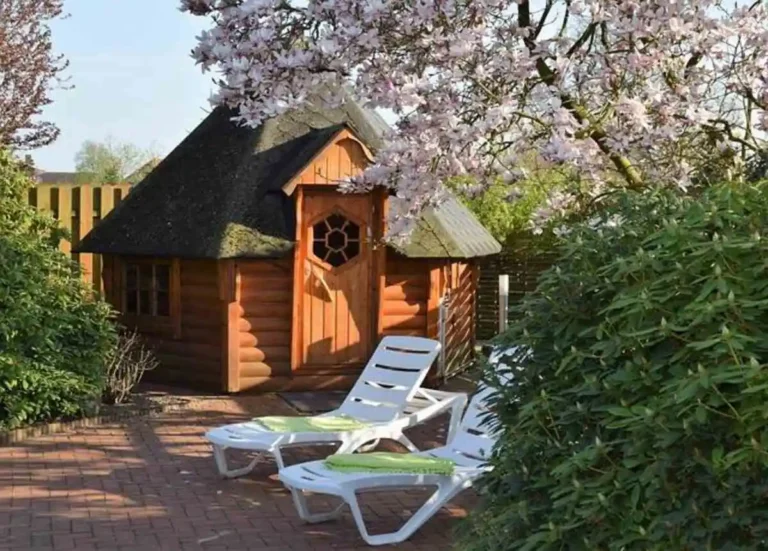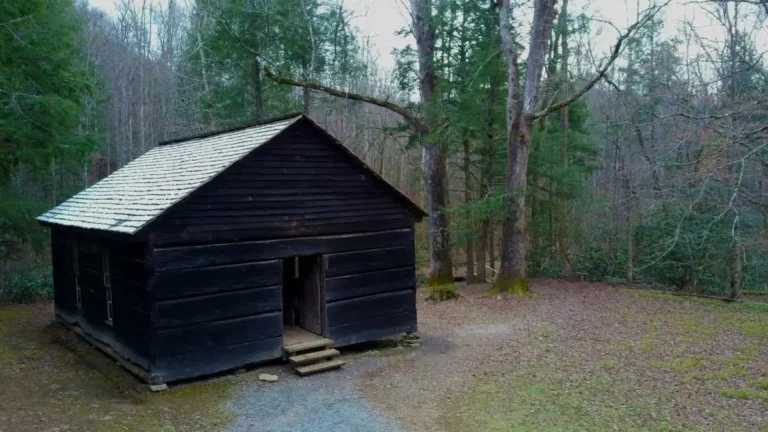How to Build an Outdoor Wood Fired Sauna: A Complete Guide
If you’re exploring how to build an outdoor wood-fired sauna, you’ll love the unmatched relaxation it offers. The natural, radiant heat from a wood-fired sauna feels softer and more soothing than electric or gas alternatives—making it a favorite among sauna purists.
Opting for wood as a heat source helps you to connect your sauna to traditional sauna practices. It offers a plethora of benefits that include improved blood circulation and a more affordable option.
These portable saunas, often made of wood, can be a thing of beauty, as they meld beautifully into outdoor settings, providing a beautiful retreat to nature. In this guide, we’ll explore essential steps, considerations, and tips to help you design and construct your very own wood-fired sauna.
Planning Your Sauna Project
Learning how to build an outdoor wood-fired sauna is an incredibly rewarding project, though it requires careful planning and consideration. This initial phase is crucial—it ensures your DIY outdoor wood-fired sauna not only functions perfectly but also blends harmoniously with its natural surroundings.
To kick things off, here are essential factors to consider:
- Ensure you have level ground and enough space for a structure at least six feet wide and seven feet high.
- Materials: Choose 100% clear-grain wood for the interior. Avoid knots to ensure durability.
- Don’t skimp on insulation, especially if you live in colder climates, where 6-inch studs and proper insulation can make a significant difference.
- Plan for adequate ventilation. In particular, windows shouldn’t be less than 24 inches from the stove.
Determine Optimal Sauna Location
Choosing the best location for your sauna might be the most important decision you’ll make. Consider how sun exposure and wind direction can improve your sauna experience. Convenience to bodies of water will help center wood management and cleaning routines.
Additionally, think about the surrounding landscape in terms of privacy and aesthetics to develop a place of peace and restoration. Construction and maintenance accessibility is essential, so plan for how you can continuously access your sauna for upkeep.
Finally, be sure to look up local zoning rules to prevent headaches down the road.
Check Local Building Codes
Here’s how to verify compliance:
- Research regulations that may affect your project.
- Obtain necessary permits to avoid penalties.
- Consult local authorities to ensure you meet all requirements.
Plan for Wood Storage
No one wants a sauna that doesn’t heat well! Effective wood storage is a key to your sauna’s performance. Consider these best practices:
- Keep firewood dry and accessible.
- Locate storage away from sauna access points.
- Protect stored wood from pests and moisture.
- Keep the wood storage area as dry and ventilated as possible to avoid the wood decaying.
Design Considerations
When learning how to build an outdoor wood-fired sauna, intentional design makes all the difference. Every element – from materials to layout – must work together to create a space that’s safe, functional, and deeply relaxing. Here are the essential design considerations for your perfect wood-fired sauna:
- Size and layout
- Material selection
- Ventilation options
- Seating arrangement
- Natural light integration
Striking a balance between movement efficiency and visual beauty can make the pedestrian environment both functional and inviting.
Comfort & Function
A comfortable sauna that works for the user’s needs can be created with careful design considerations. For example, using natural materials warms the aesthetic while providing superior insulation. Design decisions have a huge impact on the overall experience, so think about how each component works with the others.
An open, welcoming floor plan encourages guests to explore and to gather.
Sauna Size and Layout
Determining the appropriate size involves several factors:
- Number of users
- Available outdoor space
- Heating efficiency
An arrangement that allows for 2-3 visitors to sit helps them engage with each other, relax and feel at ease. Design for at least 24in of bench length per person to provide enough bench seating.
When planning how to build an outdoor wood-fired sauna, ceiling height becomes crucial for proper steam retention. Aim for at least 7 feet to create that authentic, enveloping heat experience. Remember that size directly impacts your wood-fired sauna’s efficiency – larger spaces require more energy to reach and maintain ideal temperatures, so balance comfort with practical heating considerations.
Choose a Design Style
Popular design styles include:
- Traditional Finnish
- Modern minimalist
- Rustic cabin
Each style will be a direct reflection of the client’s personal taste and will further enhance the existing outdoor aesthetics. Lastly, think about how the sauna’s design will complement your home and garden.
Where traditional designs highlight the beauty of natural wood, modern styles frequently take the opposite approach, championing geometric lines and cutting-edge materials. Selecting the most appropriate style will make your outdoor area extremely inviting and functional.
Balance Tradition and Modernity
Including traditional cues deepens modern designs. Elements such as natural wood benches and stone accents can help alleviate this dissonance between the contemporary design and historic surroundings.
New innovation, such as state-of-the-art heating systems, increases comfort while preserving the past. By customizing your sauna, it can better represent your individual preferences.
Select Durable Materials
Selecting durable materials
When planning how to build an outdoor wood-fired sauna that will last generations, material selection becomes absolutely critical. The right choices will ensure your wood-fired sauna remains safe, efficient, and durable through years of use. This guide covers essential material selection tips for outdoor sauna construction, helping you choose options that perfectly match your needs and climate conditions
- Garden ideas courtesy of chelseamarketgarden.com
- Untreated cedar or spruce wood
- Insulation (fiberglass batts or dense pack mineral wool)
- Durable material for the foundation—like concrete or treated wood
- Weather-resistant siding (composite, treated wood, or cement board)
- Galvanized nails and screws
Choosing durable, weather-resistant materials is important to ensure your work will last. If not constructed using appropriate materials, moisture exposure can cause rot and significant structural deterioration.
For example, utilizing treated wood or composite materials for exterior trim and siding can go a long way towards increasing the longevity of your sauna experience.
Wood Selection for Structure
- Select Durable Materials Spruce treeBeetle kill pine (cheap in Colorado)
Cedar and spruce are good species to consider, in large part because they’re naturally resistant to moisture. Choosing kiln-dried wood for long-lasting stability with the lowest possible risk of warping is essential.
With each wood type adding its own unique aroma, this will enrich the sauna experience. Be sure to use quality materials, especially when sourcing wood, which should be sourced from responsible suppliers.
Foundation Material Options
- Foundation Materials:
- Concrete
- Treated wooden beams
Durable materials provide a strong foundation that structural integrity springs from. Concrete may provide a hardcore base of stability, but if budget is a priority, wooden foundations can save costs.
The type of foundation affects insulation and moisture management, so proper drainage is important to avoid water damage.
Weather-Resistant Siding Choices
- Siding Materials:
- Treated wood
- Composite materials
Using treated wood or composite siding will improve the durability of these materials. Detailed attention to installation details will minimize moisture infiltration and routine maintenance will maximize siding performance.
Other durable materials I operated on 1×6 tongue and groove siding with 2″ galvanized box nails for a solid hold.
Foundation and Flooring
A good foundation and flooring system is important for your long lasting, beautiful outdoor wood-fired sauna. When done right, a solid foundation will set up comfort and durability for years and decades to come. Here are a few steps to get you started.
Prepare the Ground
- Clear the site of debris and vegetation.
- Level the ground, removing any high spots.
- Compact the soil to create a stable base.
- Ensure proper drainage away from the sauna.
Start by preparing a level space where you’ll construct the sauna. Clearing plants, rocks, and other debris now helps eliminate future plant growth that can wreak havoc on your structure. Getting that base perfectly level is important.
Any little bump can cause serious structural problems later on. Once cleared, compact the soil with a hand tamper or mechanical tamper to have a solid base. This treatment not only helps the sauna hold its own weight, but protects it.
Drainage is really important. Make sure the ground falls away from the sauna so water doesn’t collect near it.
Build a Solid Foundation
- Dig footings based on sauna dimensions.
- Pour concrete footings for stability.
- Ensure the foundation is level and square.
- Keep the foundation elevated to avoid moisture.
- Reinforce the foundation in frost-prone areas.
For a good, permanent foundation, begin with digging footings based on the size of your sauna. Simply pour concrete into these holes, and let it cure enough to set properly. In order for the home to not twist and warp over the years, the foundation must be level and square.
Proper drainage prevents moisture from creeping underneath—an absolute must in humid climates. If you live in a highly frosty region, make sure to reinforce your foundation.
Install Flooring Joists
- Gather treated lumber for joists.
- Space joists 16 inches apart for load distribution.
- Check that joists are level and anchored securely.
- Use insulated materials to retain heat.
- Allow ventilation beneath the flooring.
Use treated lumber for flooring joists and space them correctly. 16 inches on center is typical. Making sure they’re properly leveled and anchored is important for weight distribution.
By using insulated materials to keep your sauna hot, you’ll have a heat to fully enjoy. Constant air movement underneath the flooring materials prevents moisture from collecting, eliminating an environment in which mold can thrive.
Lay the Decking
- Select moisture-resistant decking materials.
- Lay decking boards with 1/4 inch spacing for drainage.
- Secure boards to the joists.
- Choose aesthetically pleasing materials.
- Maintain the decking regularly to prevent rot.
During deck installation, choose moisture-resistant decking materials that will hold up to the sauna’s environment. Be sure to space the boards a minimum of 1/4 inch apart to create drainage as necessary.
Either way, periodic upkeep is key to maintaining the wood’s integrity and aesthetic beauty.
Framing the Sauna
Proper framing forms the backbone of any quality outdoor wood-fired sauna, providing the structural integrity needed for safety and performance. When learning how to build an outdoor wood-fired sauna, remember this step determines your sauna’s ability to retain heat and withstand years of use through all seasons. The right framework ensures proper insulation while creating that perfect sauna environment you’re aiming to achieve
Essential Tools and Materials
- Tape measure
- Level
- Hammer
- Circular saw
- Drill and drill bits
- Wood screws
- Insulated wall panels
- Bracing materials
Sticking to a clear framing plan is key to maintaining good framing. Having an accurate plan in hand allows you to sidestep costly errors and ensure things end up the right size. Assembling the sauna in accordance with the dimensioned drawings is crucial.
Verify that the walls are plumb and square as you build. Make sure to check vertical and horizontal alignment with a level. This step is very important. Any misalignment at this stage can create large problems down the road.
Material and framing choices dramatically affect insulation values and heat retention. Insulated wall panels improve energy efficiency, making it easy to keep your sauna nice and warm.
Smart simple design A thicker wall will do an even better job with comfort, making even bigger, more comfortable spaces possible. Put windows and doors in your blueprint with care. This will help you avoid deleterious compressing and stretching which can be damaging to your insulation.
Build the Walls
- Measure and cut wall panels.
- Assemble panels on the ground.
- Lift and fasten panels to the frame.
- Install additional insulation as needed.
- Ensure all connections are secure.
The insulated wall panels allow for maximum energy efficiency. Make sure joints are aligned and tight across components to ensure no heat escapes.
In simplest terms, your wall thickness determines how well your sauna will hold heat, dictating the quality of your sauna experience.
Assemble the Frame
- Lay out the base.
- Cut and position vertical supports.
- Attach horizontal beams.
- Securely fasten all components.
- Check for squareness.
Use of quality fasteners and building for longevity is essential. Make sure your frame is both square and level as you put it together. Even slight variations will cause your sauna not to perform properly.
Be sure to check frequently for any weak points that may arise along the way.
Ensure Structural Integrity
- Check for square and level.
- Reinforce corners and joints.
- Assess for any misalignment.
- Inspect for signs of weakness.
- Schedule regular inspections.
Reinforcing corners and joints with a wooden dowel or other stabilizing material is good practice. A well-built structure is the foundation for ensuring the long-term value and functionality of your sauna.
Regular inspections go a long way in keeping that integrity intact.
Sheathing and Siding
Sheathing and siding are important aspects to consider when building an outdoor wood-fired sauna. They do this in addition to offering structural support, improving insulation and protecting the building from the elements. Using the correct materials, along with proper installation methods will help it last and stand the test of time.
Install Plywood Sheathing
- Measure and cut plywood sheets to fit the frame.
- Position the sheets against the studs, ensuring tight fits.
- Attach with roofing screws or siding nails, working from the center outwards.
- Check alignment with a level to ensure a true surface.
- Seal edges with a good quality, type exterior-grade caulk to avoid moisture infiltration.
Choosing premium plywood makes a difference. In addition, it offers excellent resistance to moisture exposure and thermal cycling. Proper fastening and alignment not only look sharp. They deliver in structural reinforcement as well as energy insulation.
Sealing the edges is important because it keeps moisture from getting inside which can ruin the sauna.
Attach Exterior Siding
- Choose siding material based on aesthetics and functional requirements.
- Cut siding boards to length before installation.
- Install the first board, ensuring it’s level.
- Overlap the boards, following the manufacturer’s guidelines.
- Secure with weather-resistant fasteners, checking for tight seals.
The type of siding you use will affect your insulation and aesthetic just the same. Weather-resistant fasteners improve long-term durability against the damaging effects of wind, moisture and other severe conditions.
Overlapping boards ensure water runoff, preventing damage. Routine upkeep is key to fending off weather wear and tear, keeping the sauna beautiful and useful for many years.
Seal Against the Elements
- Choose quality sealants designed for exterior use.
- Apply sealant around all joints, edges, and seams.
- Inspect seals regularly for wear and effectiveness.
- Check sealing around windows and doors thoroughly.
- Reapply sealant as needed to maintain energy efficiency.
Good sealing protects your sauna from moisture damage and allows the sauna to operate more efficiently. Annual inspections make sure that the seals are in good condition saving you from a costly investment.
Producing accurate, complete seals around all openings is the key to achieving full performance.
Roof Construction
Essential materials for roof construction include:
- Lumber for joists
- Plywood or OSB sheathing
- Roofing material (shingles, metal, or tiles)
- Quality sealants
- Weatherproofing membrane
Choosing a roof shape or style that promotes drainage to the perimeter is important. This is especially necessary in areas that experience heavy water runoff—a benefit that is immediately provided with a sloped roof. Make sure the roof can weather the elements.
Make sure it’s well attached to the frame of the sauna. This stability is necessary to endure a capricious storm. Selection of roofing materials, including color, can make a huge difference in insulation and heat retention. Shingles, on the other hand, provide better insulation. Although materials such as metal can reflect heat.
Add Roof Joists
To add roof joists, follow these steps:
- Measure and cut lumber to size.
- Position the joists according to your design.
- Securely anchor each joist using brackets.
- Check for level alignment.
It’s imperative to space your joists appropriately so your load is distributed evenly. This allows them to avoid sagging or structural failure. Make sure the joists are all level and fastened down tightly to give the deck plenty of strength.
As with roof trusses, the material used for joists affects overall roof strength. Wood is definitely the most common, but engineered materials like CLT or glu-lam offer much more durability. A good ventilation system is crucial in order to help avoid moisture accumulation that might otherwise create conditions for mold growth.
Choose Roofing Material
Popular roofing materials for saunas include:
- Asphalt shingles
- Metal roofing
- Wooden shingles
Every roof building material has their advantages and disadvantages. Additionally, asphalt shingles are generally the most affordable roofing option on the market, but typically don’t last as long as metal.
Metal roofing provides durability and longevity, standing up to high-temperature exposures, while wooden shingles provide beauty with flexibility. No matter which roofing material you decide on, the key to maximizing the lifespan of your roof lies in consistent maintenance.
Ensure Proper Sealing
To ensure proper sealing of the roof:
- Inspect seams and edges.
- Apply quality sealants.
- Regularly check for wear and tear.
This is one of the most important factors – and causes – of leaks. Keeping all the seals regularly inspected can keep them effective and make your roof more energy efficient.
Proper flashing and sealing around roof penetrations, including those added later after construction, is critical in preventing unwanted water intrusion.
Door and Window Construction
When learning how to build an outdoor wood-fired sauna, pay special attention to door and window construction. Optimal sizing—large enough for safety but small enough for efficiency—ensures proper heat retention while adding visual appeal and necessary ventilation to your wood-fired sauna experience
Here’s 3 steps to tackle this essential transition stage.
Essential Materials
- Solid wood or insulated materials
- Energy-efficient windows (preferably double-glazed)
- Weather stripping
- Hinges and locks
- Insulation foam
- Caulking material
Selecting high-quality, energy-efficient windows is key to maintaining insulation. Double-glazed windows prevent heat loss, making the sauna easy to heat up and stay that way. Proper sealing to protect against air drafts is just as critical.
Installing a layer of weather stripping to the exterior frames stops cold air in its tracks while keeping heat from escaping. The placement of doors and windows makes a real difference on the ability to ventilate effectively. Smart placement means more opportunities for natural ventilation, keeping spaces healthy and pleasant.
Proper maintenance is key to keeping them functioning at their best. Keep windows clean and inspect seals to prevent air leakage.
Build a Sturdy Door
- Measure and cut the door frame
- Assemble the door using solid wood
- Install hinges and a locking mechanism
- Seal edges with weather stripping
- Test for alignment and fit
Employing solid wood or insulated materials addresses the durability of the door. Sharp alignment and weather tight sealing plays an important role in avoiding exterior drafts. The door design should lend itself to retaining heat, but still be easily operable.
An easily accessible child-proof locking mechanism is greatly important.
Frame and Install Windows
- Measure and cut the window frames
- Install double-glazed windows
- Seal around the frames with caulk
- Secure the windows in place
- Regularly clean and inspect
Double-glazed or triple-glazed windows improve insulation and good installation with sealing avoids drafts. The arrangement of windows should optimize passive solar heating, natural day lighting and cross ventilation.
Without regular cleaning, window and door upkeep can leave a hazy view and lead to frustration.
Prioritize Ventilation
- Identify vent locations
- Install vents in the upper and lower sections
- Ensure vents are unobstructed
- Regularly inspect for blockages
- Adjust vent positions as needed
Airflow is essential to comfort in a sauna. Correctly located soffit and ridge vents improve airflow, reducing humidity while keeping moisture in check. Making sure vents and other openings have no obstructions improves the sauna enjoyment.
Interior Design and Features
Setting up a welcoming, functional interior space for your outdoor wood-fired sauna goes a long way toward maximizing your sauna experience. Important design features are key to how you and your visitors use and appreciate this space.
Consider the following:
- Comfortable seating options
- Effective lighting
- Quality interior finishes
- Personal touches for uniqueness
Bench Construction and Placement
When constructing sauna benches, you should follow these steps:
- Measure and plan your bench layout.
- Choose heat-resistant wood.
- Cut the wood to size.
- Assemble the benches securely.
- Anchor the benches to the floor.
Using heat-resistant materials is crucial in order to provide the safest and longest lasting installation possible. For safety while using the sauna, the benches could be anchored firmly to the floor.
Proper bench design is crucial when learning how to build an outdoor wood-fired sauna. The recommended 18-inch height and 24-inch width create optimal comfort, while regular maintenance keeps your benches looking great and functioning perfectly in your wood-fired sauna environment
Choose Interior Wood
Recommended wood types include:
- Cedar
- Hemlock
- Spruce
Using woods such as cedar contributes wonderful fragrance, taking sauna to an even more beautiful place. Using moisture-resistant materials extends durability and lessens maintenance requirements.
A variety of different woods add to the sauna’s ambiance and aroma, fostering a peaceful environment. Using wood sustainably sourced from sustainable suppliers means your sauna is as good for the planet as it is good for you.
Add Finishing Touches
Enhancing your sauna experience involves thoughtful finishing touches. Consider:
- Installing proper lighting
- Adding towel racks and hooks
- Choosing soothing colors
Well-chosen lighting creates an inviting atmosphere, and accessories including towel bars and shelves will help maintain a clutter-free environment.
These color choices play a big role in the room’s atmosphere, making it a tranquil retreat or energizing getaway. Add artwork, plants, or other personal touches to make your sauna truly your own.
Building the Wood-Burning System
Your wood-fired heater determines the quality of heat and humidity in your sauna. As you learn how to build an outdoor wood-fired sauna, proper heater selection and installation ensure both authentic steam sessions and safe operation for years to come. This critical component deserves special attention during your build.
Select a Wood Burning Stove
Consider these essential components for your wood-burning sauna system:
- A high-efficiency wood-burning stove
- Proper chimney and flue systems
- Heat-resistant materials for surrounding structures
- Safe clearance zones for installation
Selecting a high efficiency stove is an important step. It locks in the most efficient heat output while consuming less wood, creating a sauna that’s both cost effective and eco-friendly.
The design, size and heating capacity of the stove must correspond to the size and arrangement of your sauna. For example, if the sauna is larger, a more capable stove is needed to keep the desired temperature consistent.
This is how stove efficiency is evaluated and measured. The BTU rating tells you the maximum amount of heat the stove will produce. A well-designed stove not only provides comfortable, efficient heat—it’s the heart of your sauna and an important design element.
Ensuring your implementation meets all local safety requirements is crucial to prevent serious safety risks.
Install Stove Safely
Safety considerations upon installation are of utmost importance. Follow these steps for a secure setup:
- Read and understand the manufacturer’s installation guidelines.
- Ensure proper clearance from combustible materials.
- Install a chimney system that meets local codes.
Correct clearance helps prevent fire hazards and ensures that there is enough space for air circulation. You want your chimney to vent smoke outside and not allow smoke to build up in your sauna.
Continuous monitoring is required to ensure safe operation and to detect potentially dangerous conditions before they result in failure.
Design for Efficient Heat Distribution
Smooth, even heat distribution makes all the difference between a good sauna and a great sauna. Consider these strategies:
- Position the stove to promote even heat flow.
- Use reflective surfaces to boost heat retention.
- Maintain appropriate ventilation for consistent temperatures.
Correct positioning of stove allows heat to penetrate all areas of the sauna. Adding in reflective materials can help to keep the heat in, creating a more pleasant and beneficial session.
Routine checks of temperature variances keep everyone in a cozy space.
Insulation and Ventilation
Proper insulation and ventilation are essential components when learning how to build an outdoor wood-fired sauna. High-quality insulation maintains consistent heat while effective ventilation manages moisture – together they create that perfect, comfortable environment your sauna deserves. Follow these guidelines to implement both systems correctly in your outdoor wood-fired sauna project.
1. Insulate Walls and Roof
- Measure the dimensions of your walls and roof.
- Select high-quality insulation material.
- Cut insulation to fit snugly between studs and rafters.
- Seal around insulation with caulk to prevent drafts.
- Cover with a vapor barrier before finishing with wood.
Using quality materials goes a long way to help your sauna stay as hot as possible. Proper sealing methods are key to prevent cold air leaks from undercutting your hard work.
The importance of insulation thickness is extremely important in retaining heat. In fact, using a little thicker insulation can cut heating times by up to 67%.
2. Choose Insulation Materials
- Fiberglass
- Mineral wool
- Rigid foam board
- Spray foam insulation
Both fiberglass and mineral wool insulation provide superior thermal performance and are a proven choice. Select moisture-resistant materials, since saunas are very humid atmospheres.
Getting the best insulation for your sauna will go a long way to improving the overall efficiency of your oasis. That’s why it’s so important to get insulation from reliable suppliers.
3. Install Ventilation System
- Determine the best location for vents.
- Whenever possible, install intake vents low to the ground and exhaust vents near the ceiling.
- Ensure ducts are clear and adequately sized.
- Test airflow after installation.
If not managed properly, airflow can create detrimental effects on comfort and performance. Correctly located vents promote the best air movement possible, keeping harmful humidity levels in check.
4. Ensure Proper Airflow
- Regularly check vent positions.
- Monitor humidity with a hygrometer.
- Keep vents unobstructed and clean.
On the bottom are strategically placed vents that improve cross-ventilation making the sauna an even more enjoyable way to detox. Keeping your vents clean, unobstructed and functional is key to ensuring that you receive the health-boosting benefits of your sauna to the fullest.
Conclusion
Building your own outdoor wood-fired sauna creates a rewarding retreat for relaxation and wellbeing. The key to success lies in careful planning, durable materials, and precise construction – especially for insulation and framing. By following proper techniques for how to build an outdoor wood-fired sauna, you’ll create a sanctuary that lasts for years to come.
Design a cozy woodsy interior or a luxe spa retreat that fits your aesthetic. Conclusions, recommendations, provide for the safety of the public during the construction of the wood-burning system. Every aspect is important, from the flooring to the ceiling.
The work will pay off with each relaxing moment spent in your beautiful new sauna. If so, make your first move today. Your perfect outdoor wood-fired sauna starts here!


